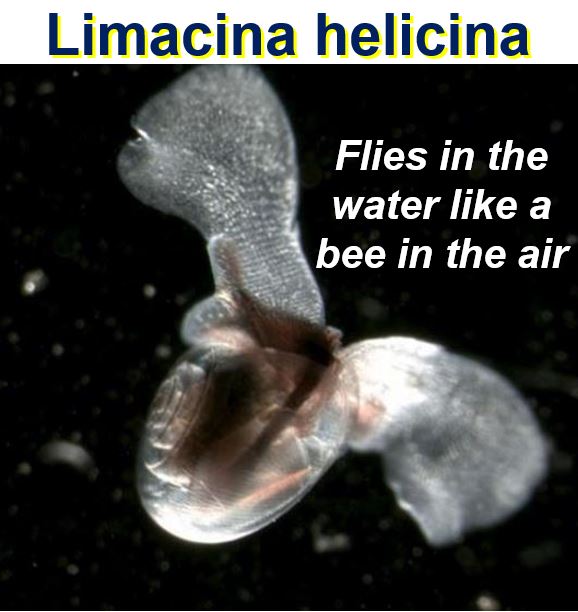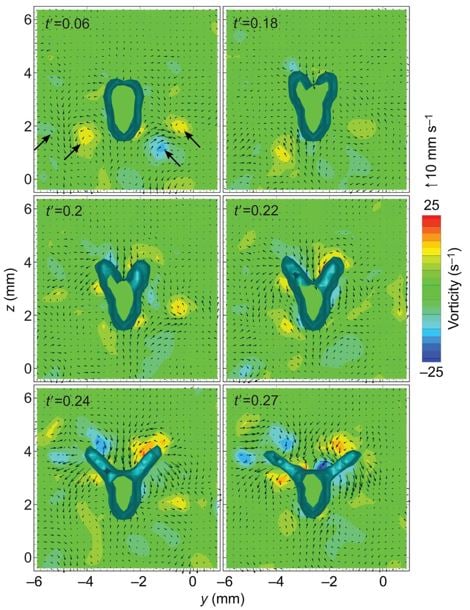A tiny sea snail flies underwater in the sea just like a bee or fruit fly does in the air. The snail, known scientifically as limacina helicina, part of the ‘sea butterfly’ family, was videoed in super-slow-motion by a team of American scientists. When its movements are slowed right down, the resemblance to a flying insect is remarkable.
David Murphy, a researcher from the Georgia Institute of Technology, and colleagues, discovered 3mm snail flaps on the sides of the creature.
After carefully analyzing the video, they discovered that these wing-like structures were being used to propel the snail through the water in all directions, something no other snail does. Most similar creatures use their appendages like flippers to paddle their way around the sea.
 Limacina helicina is a species of tiny swimming predatory sea snail in the family Limacinidae, which belongs to the group commonly known as ‘sea butterflies’. The wing-like protrusions are called parapodia, which evolved from the original gastropod foot. (Image: Wikipedia)
Limacina helicina is a species of tiny swimming predatory sea snail in the family Limacinidae, which belongs to the group commonly known as ‘sea butterflies’. The wing-like protrusions are called parapodia, which evolved from the original gastropod foot. (Image: Wikipedia)
The scientists, who published details of their study and findings in the peer-reviewed Journal of Experimental Biology (citation below), wrote that this ultra-small mollusc moves its ‘wings’ in a sequential figure-eight pattern, which generates lift in virtually the same way bees and several other insects do when flying through the air.
Fascinating example of convergent evolution
This is an amazing example of ‘convergent evolution’, the authors wrote. Convergent evolution is the process whereby creatures not closely related independently evolve similar characteristics as a result of having to adapt to similar environments or challenges.
For example, birds, some insects and bats have all evolved the capacity of flight independently – they have ‘converged’ in this useful trait. This tiny sea snail and bees have also converged in how they use their wings – one in the air and the other under water.
In an interview with the BBC, Dr. Murphy said:
“It looks like it’s flying, like a very small insect. Almost all zooplankton use their swimming appendages like paddles. I was pretty sure that the sea butterfly was going to do something similar. But I was really surprised – it turns out to be more of an honorary insect.”
Tomographic particle image velocimetry
The scientists used a system known as tomographic particle image velocimetry. They trained four high-speed cameras on a tiny volume of liquid, which is lit up with laser beams and seeded with shiny particles so that flow movements can be traced.
 When the sea snail flings its wings apart (bottom two images), fluid is sucked into the V-shaped gap between the wings. This motion generates a powerful vortex at each wing-tip, which helps to lift the creature. (Image: Journal of Experimental Biology)
When the sea snail flings its wings apart (bottom two images), fluid is sucked into the V-shaped gap between the wings. This motion generates a powerful vortex at each wing-tip, which helps to lift the creature. (Image: Journal of Experimental Biology)
“Using our four cameras, we make a 3D measurement of the flow that the animal produces as it’s swimming,” Dr. Murphy explained.
The system can monitor every minute detail of the snail’s own movements simultaneously.
Dr. Murphy continued:
“The ‘aha’ moment came when I’d spent a few months tracking the wing tips, relative to the body. I was putting all of this information into my code and finally it came out with this plot – and I saw this beautiful figure-of-eight pattern, which I immediately recognised as something more like what a fruit fly does.”
Amazingly, they also found that the snail beats its wings with the same, steep angle of attack seen in flying insects.
“And then what really convinced me, finally, was the flow information. It turns out they use one of the same tricks, to generate lift, that really tiny insects do,” said Dr. Murphy.
Known as a clap-and-fling manoeuvre, at the end of a stroke the snail slaps its wings together behind its back, and them rapidly pulls them apart. The movement sucks liquid into a V-shaped gap as the wings open up, creating tiny vortices at the tips of each wing. “Those vortices are useful in generating extra lift,” Dr. Murphy explained.
Scientists plan to study the snail further
As they gain a better understanding of how this tiny snails gets about in the water, they will learn how it finds food, avoids predators and mates, the scientists said.
Dr. Murphy and colleagues believe that designers of micro aerial vehicles (MAV) – tiny flying drones – should observe limacina helicina for new ideas.
In an Abstract in the journal, the authors wrote:
“The sea butterfly is also unique in that it accomplishes its insect-like figure-of-eight wing stroke by extreme rotation of its body (what we call ‘hyper-pitching’), a paradigm that has implications for micro aerial vehicle (MAV) design.”
“No other animal, to our knowledge, pitches to this extent under normal locomotion.”
Citation: “Underwater flight by the planktonic sea butterfly,” Jeannette Yen, Donald R. Webster, David W. Murphy & Deepak Adhikari. Journal of Experimental Biology 2016 219: 535-543. DOI: 10.1242/jeb.129205.
Video – Weird snail that flies like an insect
Sea butteflies are tiny (microscopic) snails that swim in the Arctic waters. They use wing-like structures that protrude from the shell opening, and fly around in the water just like insects do in the air. In this video, Dr. Murphy explains how he and his colleagues discovered this snail’s unique underwater flying trait.
